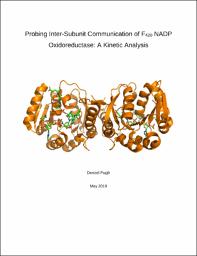| dc.contributor.advisor | Johnson-Winters, Kayunta | |
| dc.creator | Pugh, Denzel L | |
| dc.date.accessioned | 2019-05-28T22:13:14Z | |
| dc.date.available | 2019-05-28T22:13:14Z | |
| dc.date.created | 2019-05 | |
| dc.date.issued | 2019-05-20 | |
| dc.date.submitted | May 2019 | |
| dc.identifier.uri | http://hdl.handle.net/10106/28140 | |
| dc.description.abstract | F₄₂₀-dependent enzymes are important in a number of organisms, which play vital roles in methane production, NADPH regulation, nucleic acid biosynthesis, folate biosynthesis and carbon cycling. Until our recent publications on F₄₂₀:NADP+ Oxidoreductase (Fno) and F₄₂₀-dependent glucose-6-phosphate dehydrogenase (FGD), these enzymes, in general, had not been subjected to rigorous enzymological investigation. Our work has provided valuable new mechanistic and functional insights into the enzymes that use this unique cofactor. Our previous kinetic studies on Fno, which is the focus of this proposal, indicated half-site reactivity in only one of the active sites in a functional dimer. These data suggest that Fno participates in negative cooperativity kinetics and that this enzyme regulates NADPH production methanogenic organisms. Based upon our kinetic studies, we have proposed a chemically plausible mechanism and have identified several key amino acids that potentially play an important role in subunit communication within Fno. We are now poised to address three fundamental questions concerning the Fno catalyzed reaction in order to further our understanding of the Fno mechanism. The goal of my project was to investigate the functionality of conserved amino acid residues that are at the interface of the two subunits within Fno. These residues are R186, T192, S190, and H133. To answer this question, we have applied binding studies, steady-state and pre steady-state kinetic methods to assess their kinetic behavior. The data suggests that residues R186 and T192 affect inter-subunit communication. Hydride transfer becomes rate limiting and all of these amino acids are important in catalysis. | |
| dc.format.mimetype | application/pdf | |
| dc.subject | E. coli | |
| dc.subject | Escherichia coli | |
| dc.subject | F420 cofactor | |
| dc.subject | F420 cofactor, 7,8-didemethyl-8-hydroxy-5-deazariboflavin-5′-phosphoryllactyl(glutamyl)nglutamate | |
| dc.subject | A. fulgidus | |
| dc.subject | F420H2: NADP+ oxidoreductase | |
| dc.subject | FO, precursor of F420 cofactor | |
| dc.subject | Fno, F420H2:NADP+, oxidoreductase | |
| dc.subject | Half-site reactivity | |
| dc.subject | IPTG, isopropyl β-D-1-thiogalactopyranoside | |
| dc.subject | Dissociation constant | |
| dc.subject | Michaelis-Menten constant | |
| dc.subject | Luria Bertani medium | |
| dc.subject | NADP | |
| dc.subject | NADP+, nicotinamide adenine dinucleotide phosphate | |
| dc.subject | Negative cooperativity | |
| dc.subject | PEI, Polyethyleneimine | |
| dc.subject | Pre steady-state kinetics | |
| dc.subject | Steady-state kinetics | |
| dc.subject | k, rate constant | |
| dc.subject | Catalytic rate constant (turnover number) | |
| dc.subject | Wild-type Fno | |
| dc.subject | Archaeoglobus fulgidus | |
| dc.title | Probing Inter-Subunit Communication of F₄₂₀ NADP Oxidoreductase: A Kinetic Analysis | |
| dc.type | Thesis | |
| dc.degree.department | Chemistry and Biochemistry | |
| dc.degree.name | Master of Science in Chemistry | |
| dc.date.updated | 2019-05-28T22:13:14Z | |
| thesis.degree.department | Chemistry and Biochemistry | |
| thesis.degree.grantor | The University of Texas at Arlington | |
| thesis.degree.level | Masters | |
| thesis.degree.name | Master of Science in Chemistry | |
| dc.type.material | text | |
| dc.creator.orcid | 0000-0002-7909-6206 | |


